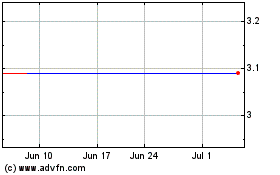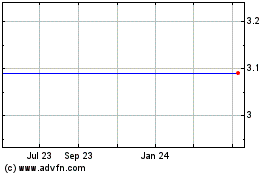China Factory-Gate Prices Snap Multiyear Negative Streak
October 14 2016 - 1:30AM
Dow Jones News
BEIJING—China's long battle with industrial deflation turned a
corner last month as a gauge of prices for factory output turned
positive for the first time in more than four years.
China's producer price index edged up 0.1% in September from a
year ago, the government reported Friday, marking the first time
the index was positive in 54 months. The index had fallen by 0.8%
in August.
The uptick into positive territory will likely give a boost to
profits and operating conditions for hard-pressed manufacturers,
whose struggles have weighed on the overall economy. Consumer
inflation is also picking up. The consumer price index rose by 1.9%
in September, more than expected, from a year earlier, accelerating
from a 1.3% gain in August. Economists said the trends herald
improved conditions for businesses and the economy.
"This will allow the corporate sector to repair its balance
sheet and profitability," said Royal Bank of Scotland PLC economist
Harrison Hu. "And it helps corporates control leverage and their
debt burden. Deflation is the most dangerous risk for China."
The turnaround in the producer price index came sooner than
expected, as it had been generally forecast to arrive in the fourth
quarter.
The index, which at its worst registered monthly declines in
factory prices of nearly 6% year over year in late 2015, started to
rebound at the beginning of this year. A median forecast from 16
economists surveyed by The Wall Street Journal had predicted a 0.2%
decline for September.
Fueling the turnaround are stable or rising global commodity
prices and efforts by Beijing to cut excess industrial capacity in
the steel and coal industries, economists said. Added to the mix
are a strongly rebounding property market and continuing
infrastructure spending, all of which have helped demand. Profits
at large industrial companies rose 19.5% year over year in August,
their best showing in nearly two years.
"Since August, prices have been rising after suffering declines
in the past," said Zhu Chengliang, a manager of Qimusen Coal Co. in
the northern city of Qinyang. He said coal prices had increased by
about 300 yuan ($45) a metric ton recently, buoyed by
government-ordered production cuts and higher transportation fees.
"The government is limiting our mining activity to 270 days a year
now. And banks are giving out fewer loans to mine owners than
before," he said.
Down the road, rising prices should help companies repay loans
with money that has a lower value than when it was borrowed,
chipping away at mounting debt loads, economists said. The
International Monetary Fund said in April that 15.5% of China's
commercial bank loans, equivalent to $1.3 trillion, were held by
borrowers without sufficient income to cover their interest
payments.
The consumer price index rose largely because of higher prices
for energy and vegetables, fruit and other food. Economists said
they didn't expect average consumer prices to rise much further in
the near future, as the central bank has signaled it wants to rein
in risks after flooding the financial system with new credit
earlier this year.
As Beijing battles a host of economic problems—from real estate
speculation in large cities to weak global demand and a sharp
decline in private investment—moderate consumer inflation and an
end to producer deflation provide a welcome bright spot, economists
said.
"Inflation will likely be a rare area that China's leadership
can be fairly relaxed about over coming years," said Capital
Economics in a report.
Liyan Qi contributed to this article.
Write to Mark Magnier at mark.magnier@wsj.com
(END) Dow Jones Newswires
October 14, 2016 01:15 ET (05:15 GMT)
Copyright (c) 2016 Dow Jones & Company, Inc.
Royal Bank of Scotland (NYSE:RBS)
Historical Stock Chart
From Mar 2024 to Apr 2024

Royal Bank of Scotland (NYSE:RBS)
Historical Stock Chart
From Apr 2023 to Apr 2024
